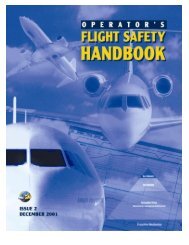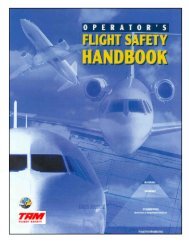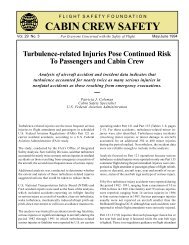Download PDF [10.9 MB] - Flight Safety Foundation
Download PDF [10.9 MB] - Flight Safety Foundation
Download PDF [10.9 MB] - Flight Safety Foundation
You also want an ePaper? Increase the reach of your titles
YUMPU automatically turns print PDFs into web optimized ePapers that Google loves.
FLIGHTTRAINING<br />
Results of Startle Experiment in Boeing 737 Simulator<br />
Stimulus Altitude<br />
(AGL)<br />
student became unresponsive, and the<br />
instructor pilot had to physically hit the<br />
student to get him to release his iron grip<br />
on the controls. A successful recovery<br />
was finally made close to bailout altitude.<br />
Denial<br />
Denial also is an emotionally focused<br />
coping mechanism, and, like freezing,<br />
a very rudimentary human process.<br />
If a person appraises the stimulus as<br />
being particularly threatening, and<br />
this mechanism is implicitly invoked,<br />
then the stressful stimulus may simply<br />
be ignored.<br />
Denial also appears to have a<br />
subconscious strategic purpose. This<br />
is remarkably common, particularly in<br />
people with life-threatening illnesses.<br />
Approach 1<br />
Lowest Alt During Go-Around<br />
With Stimulus<br />
Approach 2<br />
Lowest Alt During Go-Around<br />
Without Stimulus<br />
240 ft 170 170<br />
240 ft 170 140<br />
240 ft 170 190<br />
240 ft 160 110<br />
240 ft 160 170<br />
240 ft 150 180<br />
240 ft 150 160<br />
240 ft 150 170<br />
240 ft 150 170<br />
240 ft 140 170<br />
240 ft 140 160<br />
240 ft 200 170<br />
240 ft 220 160<br />
240 ft 86 140<br />
240 ft 66 150<br />
240 ft 56 180<br />
240 ft 0 (landed) 150<br />
240 ft 0 (landed) 190<br />
Alt = altitude, AGL = above ground level<br />
Note: The 18 participating type-rated pilots descended 36.1 ft on average during their delayed reaction<br />
to the startle stimulus induced by the researchers on their first approach.<br />
Source: Wayne Martin, Patrick Murray and Paul Bates<br />
Figure 2<br />
Many would ignore the symptoms for<br />
some time rather than confront the<br />
stressful issue of their mortality.<br />
Denying the threat’s existence can<br />
be very effective in relieving stress;<br />
however, continual reappraisal and<br />
dynamic denial are required for this<br />
coping mechanism to persist. Dynamic<br />
denial occurs when the flow of<br />
critical information is not continually<br />
processed as part of this pathological,<br />
acute-stress coping mechanism.<br />
While this could be problematic<br />
when situations such as deteriorating<br />
weather or aircraft status compound<br />
the threat, the more immediate<br />
stressors — those conducive to dynamic<br />
denial — generally are of greater<br />
concern in critical events. So dynamic<br />
denial could have severe implications<br />
in airborne critical events because of<br />
the careful analysis and logical problem<br />
solving required.<br />
The airline pilot interviews for<br />
the thesis revealed that short-term<br />
denial was relatively prevalent during<br />
these events, with participants reporting<br />
that some level of denial had been<br />
experienced in 15 of the 45 events they<br />
recalled. This was generally short-term<br />
denial, and it did not turn out to be of<br />
catastrophic consequence. However, it<br />
raises the question of how many fatal<br />
accidents have involved denial, with the<br />
pilots never achieving recovery or with<br />
recovery being delayed too long.<br />
The pilots’ interview responses also<br />
indicated that such brief periods of<br />
denial were not unusual, although in all<br />
of the situations that interviewees discussed,<br />
denial was quickly overcome as<br />
rational processing kicked in. Dynamic<br />
denial, if it had persisted, could have<br />
been particularly detrimental to the<br />
outcome of the situation, although it<br />
is impossible to tell from accident data<br />
whether denial was involved. However,<br />
there are several examples of instances<br />
in which pilots took no action at a time<br />
when intervention was required, indicating<br />
that dynamic denial is at least a<br />
possibility. Further research in this area<br />
is required.<br />
One subject specialist 23 even has<br />
described a pathological taxonomy<br />
of seven different stages: denial of<br />
personal relevance, denial of urgency,<br />
denial of vulnerability, denial of affect,<br />
denial of affect relevance, denial of<br />
threatening information and denial of<br />
information. While the early stages are<br />
mildly concerning in the aviation context,<br />
the latter stages — when threatening<br />
information or all information is<br />
denied — are particularly worrisome in<br />
the aviation safety context.<br />
32 | FLIGHT SAFETY FOUNDATION | AEROSAFETYWORLD | MAY 2013


![Download PDF [10.9 MB] - Flight Safety Foundation](https://img.yumpu.com/18550968/34/500x640/download-pdf-109-mb-flight-safety-foundation.jpg)

![Download this Issue [PDF 7 MB] - Flight Safety Foundation](https://img.yumpu.com/18859635/1/190x245/download-this-issue-pdf-7-mb-flight-safety-foundation.jpg?quality=85)
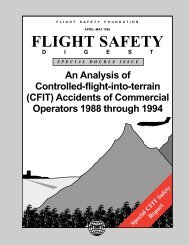
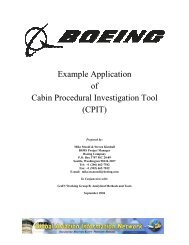
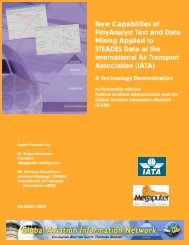
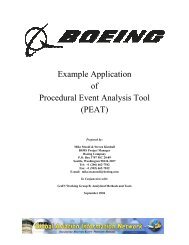

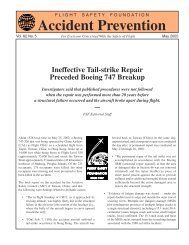
![Download [PDF 8 MB] - Flight Safety Foundation](https://img.yumpu.com/18859366/1/190x245/download-pdf-8-mb-flight-safety-foundation.jpg?quality=85)
